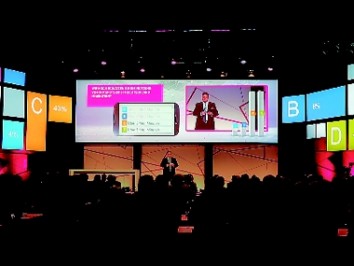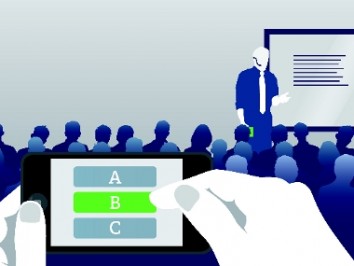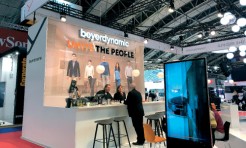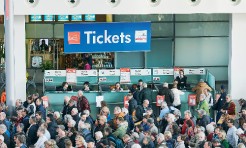How do tablets and smartphones make active participants out of listeners?
Dreary lectures in a monotonous monologue style will put any audience to asleep and are quickly forgotten afterwards. Instead of bored listeners checking their emails, they can be involved interactively with their tablets and smartphones.

Expert: Alexander Stendel
Managing Director
Zweimaleins
Berlin
Networked presentations
In a conventional presentation the speaker stands in front of the auditorium and shows slides. This was done previously with an overhead projector and later with digital projectors. Nowadays, listeners can become an active part of the presentation – the magic word is “networked presentations”. The basic principle of this “social network in small format” can be quickly described: The speaker has a smartphone or tablet on which he or she sees and controls the presentation. Thus the speaker can jump to the next slide, launch and exit surveys, as well as perform and control interactive elements. First of all, participants must log in. Then they have the opportunity to look at the slides on their own mobile devices and participate in interactive elements. In addition, the networked presentation is usually also projected. Videos can also be shown on the big screen, without being streamed to all terminals.
Build in interactions
As a rough rule of thumb, an interaction should be incorporated into the lecture after every three to five slides. For example: Participants are asked, “Which regions of Germany are you from?” Afterwards a map of Germany with the appropriate statistical distribution according to the respective home states can be seen. Four slides further, the reference can be taken up again – by demonstrating cellular telephone coverage in Germany in another map. Here the speaker can now use the acquired knowledge about the origin of the participants and link it to the second map: “Today many of you are from Bavaria, for you cellular telephone coverage is very good!” The moderator can, moreover, tap the interests of the participants. The analysis of the feedback is immediately and clearly visualised in information graphics. In this way one can respond directly to the needs of the audience.

Different numbers of participants
Depending on the presentation or conference, the number of participants varies. Statistical analyses do not make sense in a small group of ten to 50 listeners, since such results are hardly representative. Rather, it would be better to elicit individual responses. With large-scale conferences of 3,000 people things are completely differently. Generally speaking, the larger the audience, the more sensible standardised questions are from which statistics can be derived. However, it is not just about the number of attendees, but rather the proportion of active participants. During the “Dialogue Day” held by Deutsche Telekom, an application from Zweimaleins stimulated some 75 percent of the 200 invited VIP customers to join in – a top result for these “top-notch” listeners.
Various advantages
The integration of smartphones and tablets has several advantages. Obviously, the cell phone is blocked by the interactive questions. So it can not be used to read mail, which increases attention for the presentation. Beyond this, the contents of the talk remain more firmly and longer in the minds of the participants, as they have actively participated in it – the learn rate is thus higher. Another plus is spatial independence. Thus people and groups outside the walls of the lecture hall can also be asked in real time, according to the motto: What does New York think about the issue? This makes such an event more lively and exciting.

A few caveats
Limits, however, are placed on networked presentations by the existing network coverage. A miserable lecture, moreover, will not be turned into a better presentation by including smartphones and tablets. And no one should take the stage unprepared, without having practised beforehand, and attempt an Internet- based, interactive form of presentation. Poor speakers would do better to abstain from it. All others can greatly increase the impact of their presentation on the audience.
This article was published in TFI issue 3-4/2014
Share in Facebook, Twitter or Google+:
TFI - Trade Fairs International - The International Trade Fair Magazine.
© 2006 - 2024 by TFI-Verlagsgesellschaft mbH. All rights reserved. TFI-Verlagsgesellschaft mbH shall accept no responsibility for the contents of external links and other contents.
TFI-Know-how
-
What to do when things go wrong at virtual or in-person events?

In the event world, it’s simply part of life if things don’t work out as planned.
-
How can networking be made to work at online events?

Networking typically happens at real, in-person events. But it’s also possible to do it online; it just works a little differently. There are various options available to organisers.
-
How can exhibitors stand out at trade fairs?

New products and a well-conceived stand design are not the only drivers for a successful presence. Many other factors are also important, but trade fair planners often lose sight of them.
-
How can industry decision-makers be reached online?

Trade fairs and trade fair companies need to constantly further develop, become more agile and flexible and offer services all year round. New, digital offerings are very important here. With its TrustedTargeting technology, Messe München offers its customers access to leading business-to-business decision-makers on the Internet.


